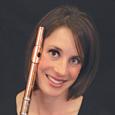Christopher Rouse completed his Flute Concerto in Fairport, New York on August 15, 1993. In the program notes he says that the piece was inspired by Celtic music. Rouse once commented, “although both of my parents’ families immigrated to America well before the Revolutionary War, I nonetheless still feel a deep ancestral tug of recognition whenever I am exposed to the arts and traditions of the British Isles, particularly those of Celtic origin.”
Dedicated to his wife Ann, the Flute Concerto was composed for Carol Wincenc and first performed on October 27, 1994 by Wincenc and the Detroit Symphony at Orchestra Hall in Detroit, Michigan. The sole recording is by Wincenc with the Houston Symphony conducted by Christoph Eschenbach.
Anhran
The first and last movements are entitled “Anhran,” which is Gaelic for song. Rouse says, “they were intended in a general way to evoke the traditions of Celtic, especially Irish folk music but to couch the musical utterance in what I hoped would seem a more spiritual, even metaphysical manner through the use of extremely slow tempi, perhaps not unlike some of the recordings of the Irish singer Enya.”
The first movement begins with a single chord played by harp and mallet percussion, out of which emerges a flute solo. The tempo indication, quarter = 120, is senza misura (without measure). I recommend a slower tempo of approximately quarter = 110. Play this opening section with freedom, avoiding a metronomic beat. The tonal center is a G that almost acts as an ornamented drone.

Play the accented notes with a firm attack while maintaining a rounded sound. Exaggerate the length of the notes before rests and end with a taper. The sound should disappear into the concert hall before you begin to play the next note. Be careful to keep the vibrato sweet and controlled throughout the first movement. Think about spinning the vibrato, keeping it inside the tone while avoiding unnecessary bumps in the line. This will help to maintain the movement’s meditative character.
Beginning at rehearsal 1, dolce, semplice, cantabile, the flute is accompanied by a soft chorale-like passage in the strings. Play on the inside of the lip as if saying moo. This should help to create a shimmering and unforced sound. The ghost harmonic exercise on page 48 of Angelita Floyd’s book The Gilbert Legacy will develop the correct air speed and help loosen the embouchure for the high notes.
The flute’s lyrical melodic line over constantly changing meters makes this movement’s compositional style unique. Maintaining rhythmic accuracy while also playing the smooth, legato melodic line is a challenge. Keep track of the eighth-note pulse within the long notes and maintain the long melodic line. Listening to a recording of yourself practicing this movement is a great way to ensure that your melodic line is well connected and rhythmically accurate.
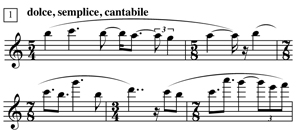
There is an error in the flute and piano score in the 58 measure before rehearsal 3. The written notes are F-G flat-A, but in the orchestral score they are A-B flat – C, which are the notes played by Carol Wincenc in the recording with the Houston Symphony.
Alla Marcia
The second movement is an energetic and boisterous march proceeding directly (attacca) from the first movement. The tempo marking is a quarter = 176, but I think that makes the music too frantic for soloist and orchestra. A tempo of approximately 160 is more preferable.
The energy in this movement should come from rhythmic integrity and clarity of articulation. It is important that each grouping of notes be played with a sense of forward motion into the next beat.
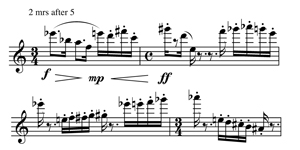
The tendency is to play the 16th of the dotted-eighth-sixteenth rhythm too slowly, almost like a triplet. To place the 16th precisely, practice playing three 16ths in place of the dotted eighth-note.
The flute often has triplets while the strings have dotted-eighth and 16th figures, and vice versa. Be sure to keep a strong sense of the beat and do not conform to the rhythm you are hearing in the strings. Listening to the steady quarter notes in the bassoons and double basses when they occur will help anchor the tempo and prevent rushing.
At rehearsal 11 the musical texture is reduced to flute, timpani, and snare drum. Consider attacking the beginning of each note with a slight accent to match that of the percussion. Alternate fingerings will help bring the pitch down in this section. I suggest the following:
For the high C – use a B fingering without the thumb
For D# – use Aflat and the first trill key
For E – use A and the second trill key
For G – use F# without the thumb
For B – add the side of the F# key to the regular fingering.
A great resource is Nestor Herszbaum’s book Alternate Fingerings for the Flute published by the Carolyn Nussbaum music company. Many of these fingerings bring the pitch down a significant amount, so play out if you decide to use them.
.jpg)
The fast and energetic trills in this movement should help propel you into the next beat. They are flutter tongued at rehearsal 22 when thematic material from the beginning returns. Play these loudly so that the flutter effect can be heard clearly.
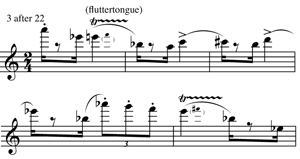
Get into the habit of studying the score so you will have a clear idea of how your part fits in with the orchestra. It may also be helpful to practice with Wincenc’s recording. It can be difficult to hear every part, but you will arrive at a stronger idea of how the piece fits together.
Another possible wrong note occurs three before rehearsal 13. The B in the flute and piano score is a D in the orchestral score and on the recording. I should mention that it is our highest D.
Elegia
The third movement is described by the composer as the “structural and emotional centerpiece of the work.” It is a mournful lament for the dead, specifically composed to the memory of James Bulger, a two-year old English child who was abducted from a mall and brutally murdered by two ten-year-old boys. The musical indication for the flute solo is doloroso, meaning sadly or mournfully, with a tempo of a quarter = 42.
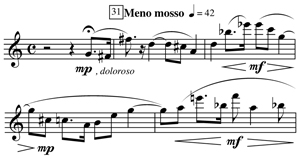
To create this mournful emotion through the flute, work for a gentle yellow or grey color that is less focused and use a light vibrato. Use fewer harmonics in the sound with a looser, more open embouchure hole. Think of having more space between the top lip and the outer edge of the embouchure hole on the flute. A good exercise for attaining this color can be found on page 24 and 25 of Trevor Wye’s Practice Book 1-Tone.
To get a pianissimo on the high B at rehearsal 32, practice the Ghost harmonic exercise mentioned above in the first movement. Listen to the F# dominant harmony in the oboes, clarinets, and bassoons in the preceding measure. Hearing the B as a resolution of that harmony will help you play it in tune.
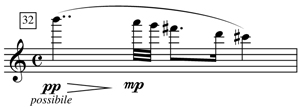
The section between rehearsal 32 and 33 is a long, dramatic crescendo in the woodwinds. Gauge your crescendo so that the A# a beat and a half before 33 is the loudest note.
After the nine-measure orchestral interlude at 33, the flute reenters at 34, accompanied by violins and basses playing a pedal tone on B. A good way to practice this section is with The Tuning CD (www.thetuningcd.com) imitating the strings on a sustained B. Use a grey sound with very little vibrato to evoke a still, calm atmosphere. The F# at rehearsal 35 should be as soft as possible, so that
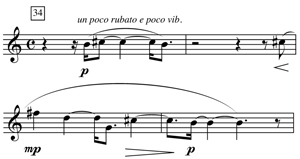
the ppp parts in the strings can be heard. We get a sense of the enormity of the horrible crime done to James Bulger when the orchestra (without flute) reaches its final climax at rehearsal 37. After this amazing crescendo, the music recedes back into the same calmness in which it began.
Scherzo
Rouse writes that the fourth movement “keeps trying to become a jig.” The tempo indication is a quarter =176, but again I recommend a slower tempo of approximately 160. Listen carefully to the opening eighths in the strings and winds to avoid entering at a faster tempo. Know where your phrases are going throughout this movement and drive the eighths forward to the longer note values.
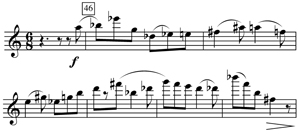
One of the most unique and exciting aspects of this concerto is the passage between rehearsals 52 and 55. The three orchestral flute parts are featured as equal partners (see right) with the solo flute in this section that is frenetic, challenging, and technically virtuosic. Rouse notes that the soloist should blend with the orchestral flutes. Consider playing slightly softer so that the flutes in the orchestra, who are seated further back on the stage, can be heard equally well. Pay attention to the steady pulse in the strings, harp, and percussion to keep the ensemble rhythmically tight.
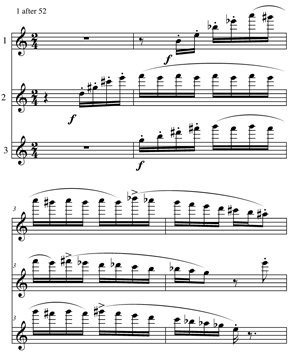
Six measures before rehearsal 55, overblow the B to Bflat to produce the Gflat to F. For the E flats at rehearsal 55 consider using the Aflat fingering plus the 1st trill key to keep the pitch down. The section from rehearsal 61 to 63 also requires alternate fingerings because of the extremely loud dynamic level. It is during this section that we hear an obvious statement of the jig, but the jig is lost when the tempo accelerates to a point where the music becomes almost out of control.
Gradually the chaos recedes and without a break the flute leads us into the final movement.
Anhran
In an arch-like form, this piece ends si milarly to how it began. The audience should have a sense of calmness, which is certainly needed after the intensity of the second, third, and fourth movements. Again, think about playing with the inside of your lips (more puckered) and add more space between the teeth, to decrease the intensity of your sound. Explore areas that can be played with little or no vibrato.
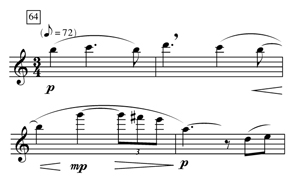
The music at rehearsal 66 is an ornamented variation of this movement’s opening melody. While it is marked piano, it can be played with more intention in the sound.
The final two measures of the piece at rehearsal 68 are unmeasured and similar to the beginning of the concerto. However, this time the flute begins the senza misura solo, and the harp and mallet percussion chord brings the piece to an end. The flute’s last note should disappear into the chord. The first grace note at rehearsal 68 is a Gflat in the flute and piano score, but G natural in the orchestral score. Wincenc plays G natural on the recording.
Rouse’s flute concerto is a passionate piece, often with dissonant harmonies, energetic rhythms, and melodies that evoke a wide range of emotions. One of the most interesting examples of this can be heard in the use of specific intervals at the very beginning and ending of the piece. The senza misura solo at the beginning of the first movement revolves around a G. The highest note in that section is a Bflat, which forms a minor third with the G, evoking sadness. The lowest note is a C#, which forms a tritone with the G, creating uncertainty and anxiety.
In the senza misura solo at the end of the fifth movement, the G rests an octave lower than the beginning. The highest note is now a B natural, which forms a major third with the G, creating a sense of peace. Finally, the penultimate note of C# is now replaced by a D, forming a traditional dominant to tonic relationship. The music comes to a final resting point, a result of the catharsis brought about by the more dissonant music heard earlier in the piece.

